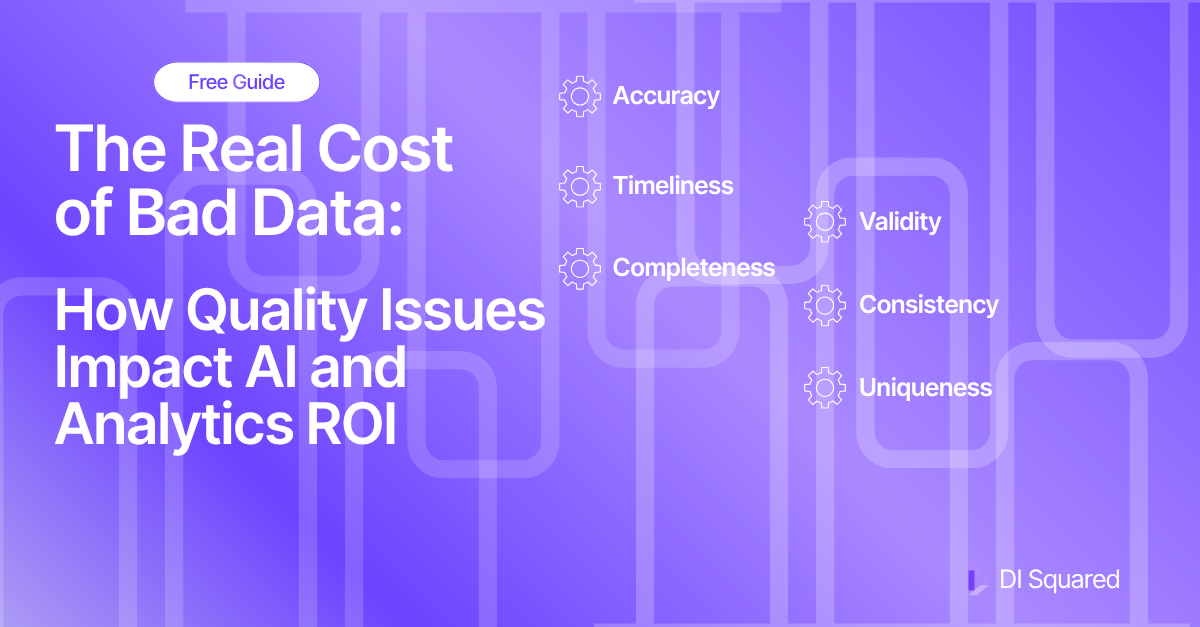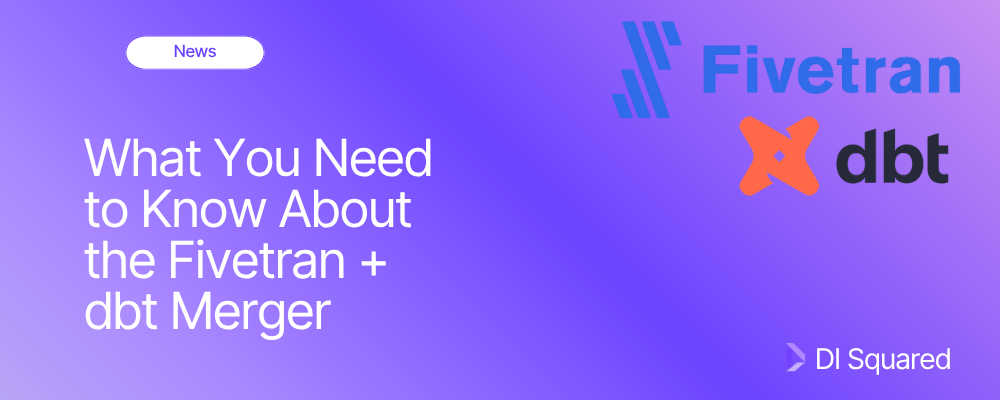Change Data Capture in 2025: The Rundown
In the world of data, operating without Change Data Capture (CDC) is like playing checkers while your competition plays chess. While you’re making reactive, one-move-at-a-time decisions based on stale data, they’re thinking strategically by monitoring every shift on the board in real time and responding with precision.
The cost of inaction is steep. Decisions based on yesterday’s data ultimately lead to delayed insights, missed opportunities. You wouldn’t want that in your daily life, and you certainly don’t want it when running a business.
DI Squared has worked on CDC projects across the board, but we wanted to offer a deeper dive into what CDC is, why you might use it, as well as the tools we explored and how they work. I look at how ETL and CDC complement one another, too, so that you can better cover all of your use cases with the most appropriate methods and tools.
In part two of this series, I explore how technologists can go about selecting the right CDC tool for their use case(s), and what that might mean for your organization's data strategy.
Now, let’s get going.
Table of Contents (what you’ll learn in this guide)
- What is Change Data Capture?
- CDC vs. ETL
- Methods of CDC
- Tool Selection
What Is Change Data Capture?
If your business is still stuck waiting for nightly updates, it’s time to rethink your game plan.
CDC is a data integration approach that identifies and captures changes – such as inserts, updates, and deletes – made to data in a source data system, and then delivers those changes to a downstream system in real time or near-real time.
Rather than repeatedly moving entire datasets on a fixed schedule, CDC focuses on capturing only new or modified records, making data replication far more responsive. This approach is particularly valuable for keeping analytical systems or cloud data warehouses (as two examples) in sync with transactional databases without overwhelming networks or systems with redundant data.
At its core, CDC acts like a real-time translator between the systems that generate data and the systems that consume it. For example, when a customer updates their shipping address in an e-commerce application, CDC captures that specific change and delivers it to a shipping database instantly, which has ripple effects that are felt throughout the company more broadly. If you're a box company, and you ship your customer’s order of 1,000 boxes to the wrong address, you’re in trouble (now imagine 10 customers with 10 incorrect addresses... you get the gist).
CDC has become a keystone in the data integration field, too, because it directly addresses the growing limitations of traditional ETL (Extract, Transform, Load) batch processing, namely latency and difficulty scaling to meet real-time demand. In an environment where decisions need to be made based on the aforementioned most current data, CDC is the Great Synchronizer.
CDC also helps organizations modernize their data architectures by integrating seamlessly with cloud-native platforms and streaming systems like Apache Kafka or AWS Kinesis. In this role, CDC becomes the “event producer” in an event-driven architecture, triggering downstream analytics, alerts, or workflows based on live data.
So when would you choose CDC over ETL?
CDC vs. ETL: When, why, how?
ETL jobs often run in scheduled batches (like nightly or even hourly – your optimal interval) and involve extracting large volumes of data, transforming it to fit the target schema, and then loading it into the destination.
While this method works for many historical reporting needs, it falls short in scenarios that require timely insights or operational responsiveness. Because batch processes often reprocess entire tables, they can place unnecessary load on source databases and increase compute costs in the cloud...and they may call for more storage than you really need. As data volumes grow, your processing windows get longer.
This is where CDC steps in, either as a replacement for traditional ETL in real-time use cases or as a complement to it in hybrid pipelines. With CDC, changes are captured as they happen, so you don't have to scan entire tables repeatedly. This dramatically reduces system load and enables downstream systems to reflect current-state data without waiting for the next ETL cycle.
Methods of Change Data Capture
CDC can be implemented through several different methods, each with its own strengths, limitations, and ideal use cases. Below, I break these down to more clearly illustrate when and why CDC works. Some factors your method hinges on:
- Database compatibility
- System performance
- Data volume
- How current downstream data needs to be
Four methods of CDC in a nutshell
TL;DR
Each CDC method we’ll go through has its place and time, depending on your infrastructure and data requirements. For real-time systems that demand high performance and scalability, log-based CDC is usually the best option. Trigger-based CDC is valuable when you need detailed control over change logic, while timestamp-based CDC offers a lightweight solution for systems with predictable, low-volume updates.
Log-Based CDC is one of the most efficient and widely used methods. It works by reading from a database’s transaction logs (e.g., MySQL binlog, PostgreSQL WAL, Oracle redo logs). These logs already capture every insert, update, and delete operation, so this method doesn’t require modifying the database schema or adding overhead to the application.
What use cases is log-based CDC best suited for?
Because it’s minimally invasive and highly performant, log-based CDC is ideal for high-throughput environments and real-time data replication. It also ensures transactional integrity and captures the full history of changes, including before/after values. This makes it a solid choice for mission-critical applications.
Drawbacks: It may require elevated permissions and database-specific configurations.
Trigger-Based CDC uses database triggers to record changes in a separate audit table or stream them directly to a target system. This method offers fine-grained control and is often used in databases that don’t expose transaction logs or in scenarios where custom filtering or transformation needs to occur as changes are captured.
What use cases is log-based CDC best suited for?
Trigger-based CDC is best suited for smaller-scale environments or legacy systems where access to log files is restricted or unavailable.
Drawbacks: That said, triggers can add performance overhead, particularly on write-heavy tables, and can complicate database maintenance.
Timestamp-Based CDC relies on a column such as last_modified or updated_at to identify recently changed records. By periodically querying for records with a newer timestamp than the last processed value, this method offers a non-intrusive way to capture changes. It’s easy to implement and doesn’t require access to logs or database internals, making it suitable for low-volume use cases or systems where schema changes are rare.
What use cases is timestamp-based CDC best suited for?
Timestamp-based CDC is often used when ease and speed of deployment outweigh the need for real-time precision.
Drawbacks: BUT it can’t detect deletes without additional tracking mechanisms and may miss updates if timestamps are not properly maintained.
Snapshot or Diff-Based CDC involves taking full snapshots of a dataset at regular intervals and comparing them to previous versions to identify changes. This method is the most resource-intensive and typically reserved for situations where no other CDC option is feasible, such as legacy systems without triggers, logs, or reliable timestamps.
What use cases is snapshot-based CDC best suited for?
While not ideal for frequent or large-scale data changes, snapshot-based CDC can be useful for periodic reconciliation, audit trails, or initial data loads where latency is not a concern.
Drawbacks: Snapshot-based CDC, though least efficient, provides a fallback when all other approaches are off the table. The key is aligning the method with your operational needs, performance constraints, and data integrity requirements.
Choosing the Right CDC Tool
Choosing the right CDC tool is all about finding what fits your specific needs. Start by making sure the tool supports both your source and target systems, like the databases you use and where you need the data to go. If you mix on-prem and cloud systems, or work with multiple data destinations, you’ll want a tool with broad connectivity.
Next: How fast do you need your data? For real-time updates or near-instant processing, go with tools that specialize in streaming, like Debezium. But if your needs are more relaxed, like daily reports, a tool that works in batches might be easier and save you money.
Another thing to weigh is usability versus flexibility. Managed tools like Fivetran are simple to set up and run but might not give you as much control. Open-source options like Debezium take more effort but are highly customizable.
Explore our follow-up guide to discover some of the most widely used CDC tools available today, along with insights into their advantages, limitations, and best-fit scenarios.
How DI Squared Helps in an Era of Real-Time Everything
If you’re deciding between methods, and want a helping hand figuring out which is the best strategy for your use cases, go ahead and put some time on our calendar. Our job (and favorite thing to do) is to advise you.





